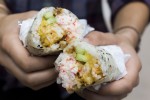Food trucks are a vital part of the Los Angeles culinary scene, with many accumulating hordes of followers who aggressively pursue them around the city. The sheer magnitude of trucks can make dining choices difficult, but columnist Alisha Kapur has narrowed down 10 to try out and review. Join her as she goes across the city, experiencing everything from Korean barbecue tacos to gourmet ice cream, in an attempt to find the food trucks that are worth following.
I came to the Jogasaki Sushi Burrito truck confused.
First, I wondered what a sushi burrito was. I chatted with another first-time customer in line, and we decided that it was most likely a tortilla stuffed with sushi fixings. Thankfully, I discovered a sushi burrito is something even better: a sushi roll, unsliced.
The truck has an overwhelming number of options to choose from, so I asked the cashier for a recommendation, and he told me that a lot of visitors enjoy the Popcorn Lobster burrito. In this specialty, the chefs meld together crab meat, avocado, cucumber and langostino tempura in a blanket of soy paper.
Since I was hungry, I looked past the mini size burritos straight at the regular size. My first bite was filled with tender, creamy crab meat. The burrito was larger than a regular sushi roll, and, although the abundance of other fixings somewhat buried the taste of the langostino tempura, the entree came together well.
The freshness of the burrito, with its crunchy cucumbers and perfectly green avocado, was impressive. Despite the quickness with which it was prepared, the sushi rivaled that from some of the best Japanese restaurants that I have tried.
The beauty of the sushi burrito is in its portability. Usually, getting sushi is a task, and I expect to go out and spend a significant amount of time and money on my meal. The sushi burrito provides a fast-food alternative to Japanese restaurants that tastes just as good, if not better. I ate it while I strolled to class, unburdened by the norms that a sit-down dining out experience usually entails.
However, a traditional restaurant experience allows customers to try many different rolls. Often, diners order multiple rolls and share with their friends. The sushi burrito does not allow customers to do this. One burrito costs the amount of a normal, fairly expensive sushi roll – mine was $13.50 – and holding two burritos seems inconvenient, if not absurd.
The lack of diverse flavors can bore a consumer’s taste palette. I enjoyed the first half of my burrito wholeheartedly, but I wanted the other half to be something else. If I were on the run and craving sushi, I would pick up one of these burritos, but I still appreciate the perks of a nice night out with friends at a Japanese restaurant.
Do you know any food trucks in Los Angeles worth sampling? Email Kapur at akapur@media.ucla.edu.
